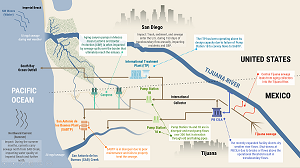USMCA Tijuana River Watershed
And Adjacent Coastal Transboundary Wastewater Flows
In the Tijuana River Valley and neighboring coastal areas, contaminated flows from Mexico enter the U.S. and create significant negative impacts to water quality, public health, and the environment. In 2020, the U.S. government, through the U.S. Environmental Protection Agency, committed $300 million in the United States-Mexico-Canada Agreement (USMCA), to identify infrastructure solutions to mitigate this decades-old problem. The USMCA requires EPA, in coordination with eligible public entities, to carry out the planning, design, and construction of high priority treatment works in the Tijuana River watershed to address transboundary flow pollution.
In September 2024, EPA formally transferred USMCA funds to the U.S. International Boundary and Water Commission for the South Bay International Wastewater Treatment Plant (SBIWTP) Rehabilitation and Expansion Project. For more information and updates on this important project, refer to the SBIWTP project page.
- Transboundary Flow
- Pollutants in this Flow
- Negative Impacts of these Pollutants
- Infrastructure Solutions: Strategy to Expedite Implementation
Transboundary Flow
Transboundary flow refers to the movement of water across an international boundary—in this case, from Mexico into the U.S. These flows contain a combination of treated wastewater, untreated wastewater, groundwater, and stormwater. There are three major points of entry for these transboundary flows:
- Tijuana River, conveys flows from the City of Tijuana, through the Tijuana River Valley in Southern California, and discharges into the Pacific Ocean. Although there are no transboundary flows for an average of 212 days of the year (2015-2019), wet-weather events cause an average of 109 million gallons per day of transboundary flows.
- San Antonio de los Buenos (SAB) Creek, releases 50 million gallons of flow, of which a significant percent is raw sewage, into the Pacific Ocean each day. Northward currents carry the discharge up the coast to the U.S. causing marine transboundary flows.
- Cross-border Canyon tributaries at the U.S.-Mexico border act as entry points for transboundary flow. Flows from these canyons enter the Tijuana River.
Pollutants in this Flow
- Untreated wastewater, often referred to as sewage, enters the flow due to spills from wastewater pipeline breaks, aging wastewater treatment systems, poorly maintained manholes and canyon collectors, lack of stormwater drainage systems, and homes without plumbing.
- Trash from Tijuana’s urban area, when not properly disposed, enters the flow with an increased volume during wet-weather events.
- Sediment, usually eroded soil from the canyons and upstream of the Tijuana River, increases in the flow during wet-weather events.
Negative Impacts of these Pollutants
Pollutants negatively impact water quality in the Tijuana River Valley and the Pacific Ocean.
- Public Health and Beach Water Quality: Untreated wastewater contains harmful pathogens that pose risks to human health. To minimize human contact with untreated wastewater during transboundary flow events, local governments mandate beach closures, reducing access to fishing, swimming, surfing, other recreational activities, and tourism. Sediment and trash contribute to flooding, which pose public safety and property loss concerns.
- Wildlife and Habitat: Sediment, trash and polluted wastewater can also negatively impact aquatic and terrestrial wildlife and degrade the riparian, marine, and estuarian habitats that wildlife relies on to thrive.
- Government Activities: U.S. Navy and Customs and Border Protection personnel are sometimes exposed to untreated wastewater while performing their job duties. The presence of trash and sediment also poses challenges to U.S. Navy and Customs and Border Protection personnel in carrying out their mission support operations.
Infrastructure Solutions: Strategy to Expedite Implementation
EPA is advancing an implementation strategy to accelerate execution of infrastructure solutions to address chronic transboundary flow pollution through:
- State and Local Stakeholder Engagement promotes transparency in decision making and supports identification of an infrastructure solution that is broadly supported by the public.
- Technical Evaluation of Infrastructure Solutions supports sound decision making through robust analysis of feasible projects with potential to comprehensively address both transboundary flows in the Tijuana River and the Pacific Ocean.
- National Environmental Policy Act (NEPA) Implementation ensures that potential US-side infrastructure solutions comply with NEPA requirements.
- Binational Engagement ensures that EPA is coordinating with Mexico to advance a solution that will address the chronic transboundary wastewater flows.

